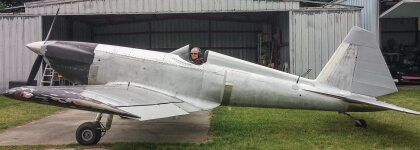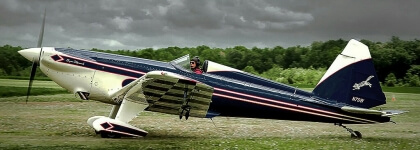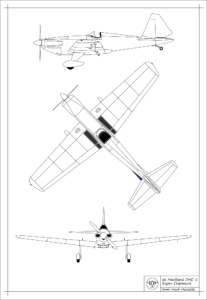The de Havilland Canada DHC-1 Chipmunk is a tandem, two-seat, single-engined primary trainer aircraft developed and manufactured by Canadian aircraft manufacturer de Havilland Canada. It was developed shortly after the Second World War and sold heavily throughout the immediate post-war years, being typically employed as a replacement for the de Havilland Tiger Moth biplane.
The Chipmunk holds the distinction of being the first postwar aviation project conducted by de Havilland Canada. It performed its maiden flight on 22 May 1946 and was introduced to operational service that same year. During the late 1940s and 1950s, the Chipmunk was procured in large numbers by military air services such as the Royal Canadian Air Force (RCAF), Royal Air Force (RAF), and several other nations’ air forces, where it was often utilised as their standard primary trainer aircraft.
| Full Specs | ||
| DHC-1 Super Chipmunk N7DW | Stock DHC-1 Chipmunk | |
| Length | 25 ft 5 in | 25 ft 5 in |
| Wingspan | 31 ft | 34 ft 4 in |
| Height | 7 ft 6 in | 7 ft |
| Weight | 1,620 lbs. empty, 2,200 lbs MTOW | 1,517 lbs empty, 2,200 lbs MTOW |
| Power loading | 6.7lb/sq ft at Single Pilot Aerobatic Weight (with 280 HP) |
15.2 lb/sq ft |
| Engine | Lycoming Thunderbolt 280 HP AEIO-540 EXP | de Havilland Gypsy Major 1C (4-cyl inline inverted), 145 hp |
| Prop | 83-in Hartzell HC-C2YR-4CF constant speed | 81-in Fairey Reed fixed pitch |
| Fuel capacity | 22 gal (13 gal ferry tank fits in front seat) | 22 gal British, 28 Canadian |
| Top speed | Low cruise 120 KIAS (11 gph), high cruise 145 KIAS |
Cruise 95 KIAS, top speed 120 KIAS VNE 155 KIAS |
| Stall speed | VSO 46 KIAS | VSO 43 KIAS |
| Max rate of climb | 3,000 fpm | 900 fpm |
The type was also produced under licence by de Havilland in the United Kingdom, who would produce the vast majority of Chipmunks, as well as by OGMA (Oficinas Gerais de Material Aeronáutico) in Portugal.
The type was slowly phased out of service from the late 1950s onwards, although in the ab initio basic training role, this did not occur within the Royal Air Force until 1996, having finally been replaced by the Scottish Aviation Bulldog. However, many of the Chipmunks that had been formerly in military use were sold on to civilians, either to private owners or to companies, where they were typically used for a variety of purposes, often involving the type’s excellent flying characteristics and its capability for aerobatic manoeuvres.
More than 70 years after the type having first entered service, hundreds of Chipmunks remain airworthy and are in operation around the world. The Portuguese Air Force still operates six Chipmunks, which serve with Esquadra 802, as of 2018.



